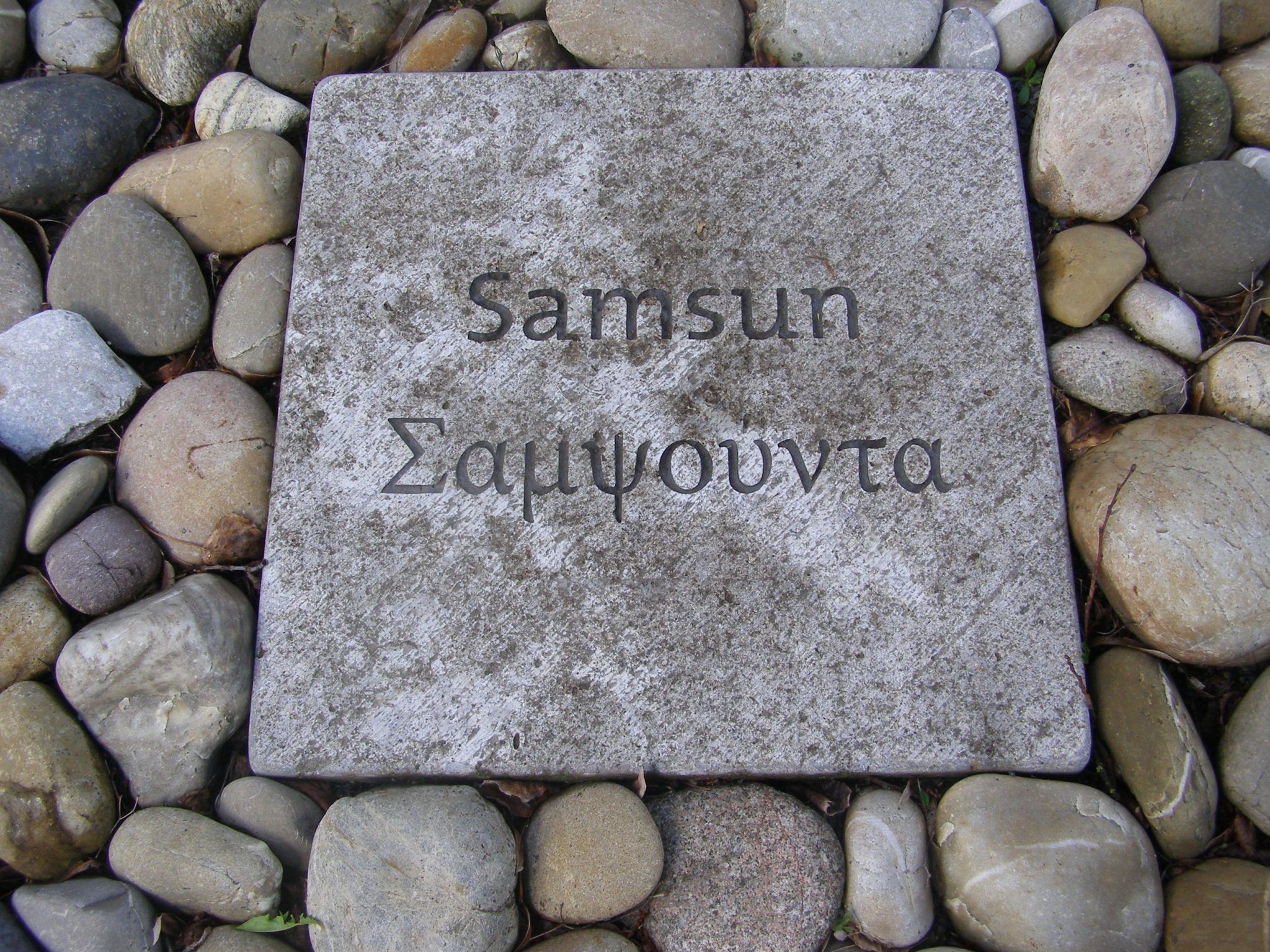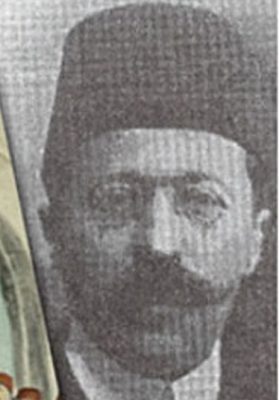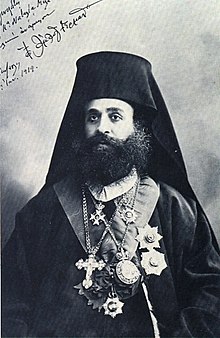
The district (sancak) was divided administratively or from west to east into the six kazas Bafra, Samsun, Çarşamba, Terme, Ünye (Grk: Oinoy) and Fatsa.
The Toponym
Samsun was known as Amisós by Greeks and Byzantines, Missos by Romans, Simisso by Genoese and then Samsun by Seljuk and Ottoman Turks. It is situated between the fertile deltas of the Kızılırmak (ancient Halys) and Yeşilırmak (ancient Grk.: Ίρις – Iris) rivers.
Ancient Amisos was founded on the flat top and eastern slopes of a plateau headland just to the west of the modern city. It did not possess a good harbor; nor was it situated near the mouth of a major river. Historically its main assets were iron, probably traded from the Chalybes, olives (mentioned by Strabo) and some silver. Historically, Amisos had intensive links with central Anatolia and looked more inland than across the Black Sea.
The ethymology of the toponym Canik for the Ottoman administrative unit is unclear. The British historian and Byzantinist Anthony A.M. Bryer attributes Canik to the ethnonym ‘Çani’ (Laz).
Armenian Population
According to the census of the Armenian Patriarchate of Constantinople and the 1914 Ottoman cesus, there lived 35,907 Armenians in the sancak Samsun/Canik, both in the towns – Samsun, Bafra, Çarşamba, Ünye (Grk.: Oinoy), and Fatsa – and in the countryside in ten villages around Ünye, four in the vicinity of Terme and 20 in the kaza of Çarşamba. In 1914, they maintained 49 churches and 79 schools in the sancak Samsun.[1]
History
The traces of the first settlement in Samsun, which was one of the most important cities of the region called Paphlagonia, has been found in the caves at the south of Tekkeköy. It is known that people lived in shelters in Tekkeköy in the Middle Stone Age (Mesolithic, 10000-1000 BC). Settlements revealed in Samsun’s city centre (e.g. Dündartepe, Kavak, Kalenderoğlu) indicate these places were occupied during the Early and Middle Bronze Age.
The oldest community that has settled within the borders of Samsun city and established a state were the Kaskians (also: Kashka, Kaska; 5000-3500 B.C.). They were followed by the Paphlagonians, who have dominated the entire North Anatolia, Hittites (3000-1100 B.C.), Phrygians (2000-1200 B.C.), Cimmerians (1182 BC-676 BC), Lydians (1200-547 B.C.); the latter established a site called Enete (Kara Samsun of today)
Greek Colonization
The Black Sea littoral was densely populated by local natives. According to historic sources, many of these were hostile to the Greeks seafarers and subsequent colonists.
In the written historical sources, it is unclear when exactly Greeks appeared on the southern Black Sea coast. However, Greek pottery from the Halys valley (between Sinope and Amisos) proves the Greeks had contacts there long before the foundation of the coastal cities. Iron Age settlements testify to significant cultural exchange in the late Archaic period (ca. 750–550 B.C.). Sites along the Halys basin yielding Greek pottery and architectural terracottas seem to indicate that the Greeks paid special attention here. The reason was due to this valley’s abundant resources such as red pigments and other minerals.
Ionian Milesians drove out from Sinope the weakened Leucosyrians (also referred to as White Syrians or Kappadocians) after a period of occupation by the Kimmerians. Sinope then conquered land from the natives to the east for her colonists.
Amisós was founded around 564 B.C. Ancient authors state two interpretations: a Milesian foundation, or a joint Ionian foundation by Phocaea and Miletos. The archaeological evidence from Amisos just adds to the confusion. No proper excavation of the settlement has been conducted because of modern overbuilding. For example, the site of the acropolis is occupied by a Turkish military base, to which there is no access. Its construction is believed to have destroyed many archaeological and architectural remains.
The Greek settlers in both Sinope and Amisos had to deal with the indigenous people from the beginning of their colonial activities, since their survival depended on access to the native territory to obtain agricultural products, minerals and metals. The presence of local pottery in Amisos suggests that the native Kappadocians formed a part of the population there. Amisos may have been founded over an already existing settlement or it could have received people from the surrounding area.
Thereafter falling under the rule of the Roman Empire at 1 B.C., Amisos remained within the borders of the Byzantine Empire when the Roman Empire was divided at 385.
Excerpted from: Sam Topalidis: A History of Amisos (Samsun), 2013. http://www.karalahana.com/2015/10/23/a-history-of-amisos-samsun/
Deportations and Massacres during WW1
During World War I, the Ottoman Turks implemented a genocide against their Armenian Christian subjects. The deportation of Armenians from Samsun began in July 1915. Samsun’s leading Armenians had previously been arrested in April 1915. In July, as the Armenian deportees began to march out of Samsun, the men were separated from their families and killed about a mile from the city.
The Swiss businessman and, since spring 1915 US-consular agent William Peter at Samsun reported in August 1915 that great numbers of Armenians had been sent inland from Samsun. Of these, most of the men were murdered somewhere beyond Amasya, while many women and children had been taken to Malatya and thrown into the Euphrates river.[2] The Ottoman authorities announced that wherever Orthodox Christians failed to report for military service, or had deserted after joining up, their community would be held responsible. [Conscription meant joining the dreaded labor battalions servicing the army because from 1915, Christians were not allowed to bear arms in the Ottoman army.] This provided an excuse for the Ottomans for a first round of village burning, and that in turn produced Christian retaliation. Many adult males from Samsun took to the mountains and joined the guerillas.[3]
In April 1916, after the Russian army occupied Trabzon, thousands of Anatolian Muslims fled westwards. The Russian occupation increased the disdain of the Ottoman authorities for their Christian (and Orthodox Christian Greek) minority which was suspected of working for a Russian Orthodox Christian victory. In December 1916, for allegedly ‘strictly military reasons,’ Ottoman War Minister Enver ordered the deportation of the Greek population from the Black Sea coast to an area of 50 km. However, the German diplomats understood that the harsh winter season and the ‘failure to organize provisions’ would lead to high casualties.[4]
On 27 December 1916, Samsun was encircled by the Ottoman army and all the population was called to the upper Samsun square (Kadıköy). All the Greeks were imprisoned. They followed their executioners on foot, all night long, through the snow-covered mountains.

Also on 27 December 1916, all notables of Samsun were rounded up without warning. They were forbidden to contact their families or to obtain any supplies necessary for the march. Early the next day, they were deported to the interior. According to E. Emmanouilidis (1867-1939), a Kayseri born Greek Member of the Ottoman Parliament for the Aydın province, who based his account on the report of Metropolitan Germanos, the city was attacked by the army on that same day. The residents of the working class area of Kadıköy were summoned to the square to listen to the commander’s announcements, and then all 4,000, including elderly, women and children, were put into custody and led to the interior of Anatolia: “In the middle of winter, they were sent marching through valleys and climbing up hills without bread, water, or the opportunity to rest. They would march on for 12 hours; after sleeping, they would march for another 12 hours. Four days later, they arrived at Havza. On the way, the ill-fated caravan which was destined for Çorum would meet similar caravans from other places, as the whole region of Samsun, Bafra and Çarşamba was being evacuated.”[5]
Based on information from Austrian sources, the German diplomats understood in early February 1917, that the “ban of the Greek population of Samsun”, which had been conducted under the pretext of pursuing Greek bands in reality was nothing else but a “large scale” persecution of Greeks. A report from the Austrian Foreign Office gives the details of the extremely cruel expulsion from the villages Aylas-köy and Kadıköy near Samsun:
„On the same day the villages, which belong to Samsun (…) were occupied by military forces and the inhabitants (3-4,000) summoned under the pretext that the mutessarif wished to talk to them, and then they were driven at night-time into the interior, without any clothing and provisions. Considering the present rough time of the year, the lack of accommodation and food many of these unfortunate will soon meet their death. (…) According to a report from Constantinople on 31 January 1917, Talaat Bey (since then Pasha and Grand Vizier) is said to have told a man of confidence that he sees the necessity for Turkey to “clean up with the Greeks as it was with the Armenians”.[6]
In December 1916 and January 1917, Pallavicini, the Austrian ambassador to Constantinople, informed his government of the latest events on the Black Sea coast, and specifically the fate of Samsun: “December 11, 1916. Five Greek villages were plundered and burned. The inhabitants were sent away. December 12, 1916. Villages around the city are on fire. December 14, 1916. Whole villages are burning, including school buildings and churches. December 17, 1916. Eleven villages were burned in the Samsun province. The plundering continues. The villagers are being abused. December 31, 1916. About eighteen villages have been burnt to the ground. Fifteen were partly burned. About sixty women were raped. Even churches were plundered.”[7]
Between December 1916 and February 1917, the German Vice-Consul Kuckhoff reported that in the Samsun region alone, on the pretext of seeking 300 Greek deserters, some 88 Greek villages were torched.[8]
Winter combined with the lack of transportation for those deportees, led to great misery. The Greeks living in Bafra and Samsun were sent to the interior towards Ankara. In some villages, the Greek inhabitants were deported with only a few hours’ notice; in others, the men were conscripted into labor battalions, and then the villages themselves were looted by their Muslim neighbours. The central government had no intension of allowing the deportees to ever return home because Muslims were systematically settled into the vacant Greek houses. Some provinces were instructed not to allow Greeks to return and resettle on the coast.
In the Samsun region, in January 1917, 4,000 inhabitants were deported, first to Havza then to Çorum. The surviving Greek deportees were resettled in former Armenian homes of the previously deported (genocided) Armenians. During the Armistice in late 1918 the surviving Greeks were able to return home.
In a series of letters [in 1919] to the Patriarchate in Istanbul, the Greek Orthodox Patriarch of Samsun, Germanos Karavangelis, states that roughly thirty thousand people had been deported from his area to the province of Ankara. Villages evacuated in three or four separate waves of expulsion had been subsequently looted and razed; additionally, the convoys of deportees had been attacked and both women and children had been killed.
Excerpted from: Topalidis, Sam: A History of Amisos (Samsun), 2013. – http://www.karalahana.com/2015/10/23/a-history-of-amisos-samsun/
Metropolitan Germanos on the Destruction of the Pontic Greeks

“First, the army reduced to ashes the entire surrounding region. Nearly all the villages, rich in tobacco plantations, civilized friends of progress and possessing a lively national sentiment, were pillaged and then set on fire. A large number of women and children were killed, the young girls outraged and immediately afterward driven into the interior. Where? Into the vilayet of Angora, to Tchoroum [Trk: Çorum], to Soungourlou [Trk.: Sungurlu], and still further. The winter was of the most severe kind; these girls had to march thirty or forty days across snow-covered mountains and sleep by night in the open. For several days they were without food, for they were not even allowed to use money to buy bread; they were continually beaten by the gendarmes and stripped of any money they might have on them, and when they got to the towns they were brutally pushed into the hot public baths, on the pretext of hygiene and cleanliness, and just as quickly dragged out. Thus, an easy prey to the rigors of the cold, they were driven on further. The majority, of course, died on the road, and none of the dead being buried at all, vultures and hogs feasted on human flesh.”[10]